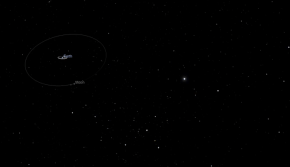 The orbit of 2020 SO around Earth and Sun from Nov. 2020 to Mar. 2021 | |
| Discovery [1][2] | |
|---|---|
| Discovered by | Pan-STARRS 1 |
| Discovery site | Haleakalā Obs. |
| Discovery date | 17 September 2020 |
| Designations | |
| 2020 SO | |
| P116rK2 [3] | |
| NEO · Apollo (May 2020)[4] Atira (Dec 2020)[2] | |
| Orbital characteristics [2] | |
| Epoch 17 December 2020 (JD 2459200.5) | |
| Uncertainty parameter 2 | |
| Observation arc | 167 days |
| Earliest precovery date | 19 August 2020 |
| Aphelion | 0.988 AU |
| Perihelion | 0.985 AU |
| 0.986 AU | |
| Eccentricity | 0.00181 |
| 0.98 yr (357.9 d) | |
| 276.388° | |
| 1° 0m 21.877s / day | |
| Inclination | 0.1389° |
| 216.656° | |
| 311.989° | |
| Earth MOID | 0.01628 AU (May 2020)[4] 0.00106 AU (Dec 2020) |
| Physical characteristics | |
| 6–12 m (assumed)[5] | |
| 0.0026080±0.0000001 h[6] or 9.39 s | |
| 22.4 (at discovery)[1] 14.1 (1 Dec 2020)[7] | |
| 27.66±0.34[4] 28.43[2] | |
2020 SO[a] is a near-Earth object identified to be the Centaur upper stage used on 20 September 1966 to launch the Surveyor 2 spacecraft. The object was discovered by the Pan-STARRS 1 survey at the Haleakala Observatory on 17 September 2020. It was initially suspected to be an artificial object due to its low velocity relative to Earth and later on the noticeable effects of solar radiation pressure on its orbit. Spectroscopic observations by NASA's Infrared Telescope Facility in December 2020 found that the object's spectrum is similar to that of stainless steel, confirming the object's artificial nature.[8] Following the object's confirmation as space debris, the object was removed from the Minor Planet Center's database on 19 February 2021.[9]
- ^ a b Cite error: The named reference
MPEC-2020-S78was invoked but never defined (see the help page). - ^ a b c d Cite error: The named reference
MPC-objectwas invoked but never defined (see the help page). - ^ Cite error: The named reference
NEO-Exchangewas invoked but never defined (see the help page). - ^ a b c Cite error: The named reference
jpldatawas invoked but never defined (see the help page). - ^ Cite error: The named reference
CNEOSwas invoked but never defined (see the help page). - ^ Peter Birtwhistle (Great Shefford Observatory). "Light curve".
- ^ Cite error: The named reference
NEODy20201201was invoked but never defined (see the help page). - ^ Cite error: The named reference
NASA-20201202was invoked but never defined (see the help page). - ^ Cite error: The named reference
MPEC-2021-D62was invoked but never defined (see the help page).
Cite error: There are <ref group=lower-alpha> tags or {{efn}} templates on this page, but the references will not show without a {{reflist|group=lower-alpha}} template or {{notelist}} template (see the help page).